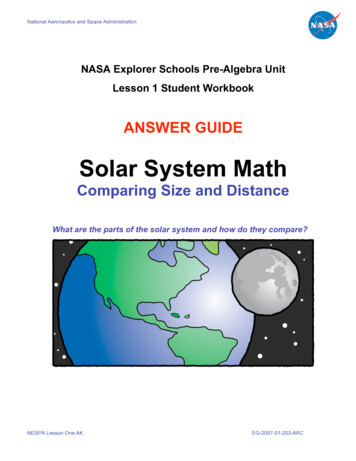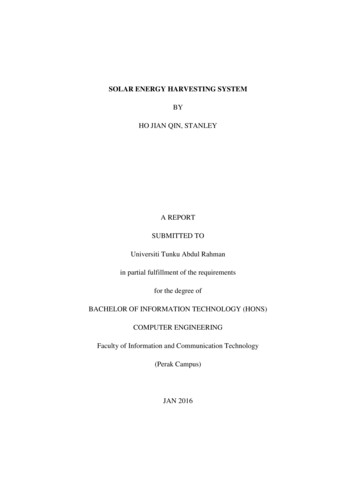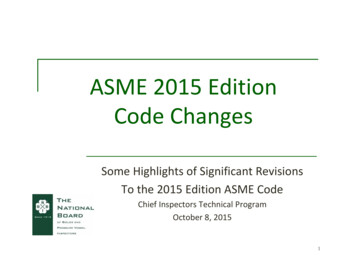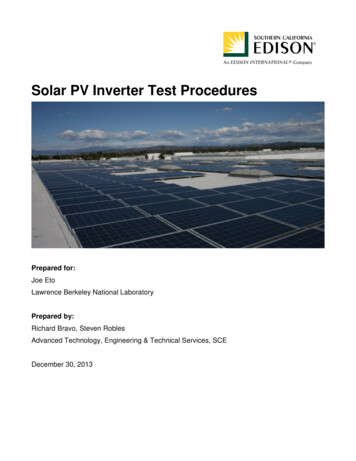
Transcription
National Aeronautics and Space AdministrationNASA Explorer Schools Pre-Algebra UnitLesson 1 Student WorkbookANSWER GUIDESolar System MathComparing Size and DistanceWhat are the parts of the solar system and how do they compare?NESPA Lesson One AKEG-2007-01-203-ARC
Student Workbook Answer Key: PRE-LESSONName:Date:Pre-Lesson ActivityStep 1: On the back of this paper draw a picture of our solar system. Inyour drawing, show the different sizes of the planets and where they arelocated. Label everything. If you have time, add color to your picture.(Student drawings will vary.)Step 2: Using the chart below, list what you know about our solarsystem in the column titled “What I know.” In the column titled “What Iwant to know” write questions you have about our solar system andspace exploration. (Possible responses are listed below.)NESPA Lesson One AK2EG-2007-01-203-ARC
Student Workbook Answer Key: PRE-LESSONName:Date:Math Review: Converting UnitsLengthVolumeMass1 kilometer 1,000 meters1 gallon ! 3.78 liters1 pound ! 454 grams1 meter 100 centimeters1 gallon 4 quarts1 kilogram 1,000 grams1 centimeter 10 millimeters1 quart ! 0.95 liter1 gram 100 centigrams1 mile 5,280 feet1 liter 1,000 milliliters1 centigram 10 milligrams1 yard 3 feet1 pint 0.5 quart1 meter ! 3.28 feet1 pint 16 fluid ounces1 foot 12 inches1 inch ! 2.54 centimetersDirections: Use the table of relationships above to solve practice problems 1-5below. You may use additional paper for doing calculations.1. Yna bought 3 gallons of milk at the store.How many liters did she buy? Approximately 11.3 liters2. Jamal caught a pass and ran 57 yards to make a touchdown.How many feet did he run?171 feet3. A car weighs 850 pounds. How much does it weigh in kilograms? (Hint: change poundsto grams, then change grams to kilograms) Approximately 386 kilograms4. Jessica runs the 100-meter dash at the track meet.How many feet does she run? Approximately 328 feet5. Bonus Question: Juan and his family traveled 339 miles from San Jose to Los Angeles.How many kilometers did they travel? Approximately 546 kilometersNESPA Lesson One AK3EG-2007-01-203-ARC
Student Workbook Answer Key: ENGAGEName:Date:Travel Planning1. If you planned a family vacation, how would you decide where to go?Possible responses: Ask family about places that interest them; Consider locations thatwere within budget; Pick a theme such as “national parks” etc.2. What factors (details about your trip) would you need to think about?a. Costc. Activities/ entertainmentb. Distance/ travel timed. Weather/ climateSpace Exploration3. What are some reasons for humans to explore our solar system?Thoughts to share: Human exploration will not only help us to answer scientificquestions, but will also advance engineering and technology. Many new technologieshave been made possible by the space program, including dental braces, rechargeablebatteries, cordless power tools, wireless telephones, satellite television, quartz watches,household smoke detectors, fireproof clothing, cardiac monitoring equipment, and eventhe global communication systems used to guide you through your neighborhood. Forevery dollar the U.S. spends on the space program, it receives 7 back in the form ofcorporate and personal income taxes from increased jobs and economic growth.4. Why should humans explore space in addition to robots?Thoughts to share: One reason NASA wants to send humans is that they can makejudgments and can adapt to changing situations. Making observations and understandingwhat you see is easier, more efficient, and more exciting in person, instead of throughpictures or data. In terms of analysis and studying samples, it takes a Mars ExplorationRover (MER) an entire Mars Day (almost 25 hours) to do what a field geologist can do in30 seconds. Ask the students to calculate the following: (Students may want to use ratioand proportion to find the answer.)Question: In just 5 minutes, how many days worth of MER work could a geologist do?Answer: In 5 minutes a geologist could do 10 days worth of rover (robot) work.NESPA Lesson One AK4EG-2007-01-203-ARC
Student Workbook Answer Key: ENGAGEName:Date:Our Solar SystemNESPA Lesson One AK5EG-2007-01-203-ARC
Student Workbook Answer Key: ENGAGEName:Date:Lesson 1 Planet Data Sheet – Inner PlanetsPlanetMercuryVenusEarthMarsDistance fromSun in km58 million km108 million km150 million km228 million kmDistance fromSun in AU0.4 AU0.7 AU1.0 AU1.5 AUDiameter in km4,878 km12,104 km12,755 km6,790 kmAvg. SurfaceTemperature662º F869º F59º F-9.4º F350º C465º C15º C-23º CAtmosphereNoneMostly CarbonDioxideMostly Nitrogenand OxygenMostly CarbonDioxideNESPA Lesson One AK6EG-2007-01-203-ARC
Student Workbook Answer Key: ENGAGEName:Date:Lesson 1 Planet Data Sheet – Outer ce fromSun in km778 millionkm1,429 millionkm2,875 millionkm4,504 millionkm5,900 millionkmDistance fromSun in AU5.2 AU9.5 AU19.2 AU30 AU39.3 AUDiameter in km142,796 km120,660 km51,118 km49,528 km2,300 km-238º F-292º F-366º F-391º F-382º F-150º C-180º C-221º C-235º C-230º CHydrogen &HeliumHydrogen &HeliumHydrogen &HeliumHydrogen &Helium(methane)(methane)Thin,freezingmethaneAvg. SurfaceTemperatureAtmosphereNESPA Lesson One AK7EG-2007-01-203-ARC
Student Workbook Answer Key: ENGAGEName:Date:A Brief History of Units of MeasurementStudent ReadingTo measure a distance between two objects you need two things: a unit of measurement(how much you are measuring by) and a tool (what you measure with). Long beforemeasuring tools like rulers and tape measures were common, people needed a way tomeasure things. In early times, people who did not have tools used parts of their bodies (liketheir thumbs) to measure.About 950 years ago, the width of a person’s thumb wasconsidered an inch. In many languages, the word for thumb andinch are the same or very close. A person’s foot was used tomeasure feet. A yard was the length from the tip of the king’s noseto the end of his fingertips.Everyone had a way to measure distances, but there was a problem. Everyone knewwhat to measure with, but there was no standard for how big things were. For example, ifyou measured the length of your bedroom with your feet, and then your friend did the samewith his feet, you would not get the exact same measurement because your feet and yourfriend’s feet are different sizes.Eventually people agreed on standards—measurements that were the same foreveryone. The Romans liked to divide things into units of 12. This is why we have 12months in the year. They decided that a foot contained 12 inches. In England in the 1100’s,King Henry I decided to use the Roman standard of measurement for feet, and he spreadthe word to his people that a foot was 12 inches long. Once the standards were set andeveryone agreed on the lengths of units of measurement, the system worked better.In the 1800’s, the French Academy of Sciences was asked to develop a system ofmeasurement that was based on scientific measurements and used the base-10 system.The Academy set their standard of measurement (a meter) as a fraction of the distance fromthe North Pole to the equator on the surface of the Earth. Larger and smaller units weremade by multiplying or dividing a meter by factors of 10. One thousand meters is akilometer. One hundred centimeters is a meter. Ten millimeters is a centimeter. Even theNESPA Lesson One AK8EG-2007-01-203-ARC
Student Workbook Answer Key: ENGAGEnames of the units indicate how big they are: kilo- means 1000, centi- means 100. Now wecan just move the decimal point to change from larger or smaller units.By the year 1900, thirty-five countries decided that the metricsystem would be their standard system of measurement. Somecountries, like the USA, did not decide that the metric systemwould be their standard system of measurement. This can be achallenge when international scientists and engineers try to worktogether on the same project!While kilometers are useful for measuring distances on Earth, they are too small formeasuring distances throughout the solar system. For example, the distance from the Sunto Jupiter is 778,000,000 km (778 million kilometers). Scientistsdecided to create a new unit of measurement, which would behelpful when measuring the solar system. They called theaverage distance between the center of the Earth and the centerof the Sun one astronomical unit (1 AU). This distance is150,000,000 km, which is roughly the number of kilometersbetween the center of the Earth and the center of the Sun. Therest of the solar system ranges between 0.4 AU (from Mercury tothe Sun) to 39.3 AU (from Pluto to the Sun).When leaving the solar system and looking at other star systems, the AU is too small forscientists’ needs. So they created a LARGER unit of measurement. Scientists measure alight-year as the distance light can travel in one year. The next closest star to Earth (afterthe Sun) is Alpha Centauri, which is 4.34 light-years away. This means that the light we seefrom Alpha Centauri at night actually left the star 4.34 years ago.Our system of measurement has evolved from using thumbs and feet to using thedistance traveled by light in one year. As our scope of the universe continues to expand, sowill our need for new standards of measurement.NESPA Lesson One AK9EG-2007-01-203-ARC
Student Workbook Answer Key: ENGAGEA Brief History of Units of MeasurementDiscussion Questions1. What is the problem with using parts of the body as a unit ofmeasurement?The sizes of different people’s body parts (i.e. feet) are not equal2. Why were customary (or standard) units established?Standard units ensure consistent, equal measuring3. What is the advantage of metric units?Metric units are based on factors of 10, making them easy to calculate4. Why is using kilometers to measure distances in our solar system aproblem?Kilometers are too small a unit for measuring large distances in space5. What standard unit in astronomy was developed to measure largedistances?One astronomical unit (AU) is the average distance from Earth to theSunNESPA Lesson One AK10EG-2007-01-203-ARC
Student Workbook Answer Key: ENGAGEName:Date:Unit Conversion: Building the Concept1. Looking at the picture of the ruler marked with inches andcentimeters, we see that there are approximately 2.54 centimeters in1 inch. Write this in the spaces below.1 inch ! 2.5 4 centimeters2. Now that you know there are approximately 2.54 centimeters in oneinch, use this information to solve the problems below. There aremany ways to find the answers. For example, you may use a ruler, ordraw a picture, or add, multiply, or divide. Show your work, and thendiscuss your method (or strategy) with the class.SolutionsPossible methods (strategies)5 inches ! 12.7 centimeters2.54 2.54 2.54 2.54 2.54 12.72.54* 1025.410 inches ! 25.4 centimeters5.9inches ! 15 centimeters15 2.54 5.9NESPA Lesson One AK11EG-2007-01-203-ARC
Student Workbook Answer Key: ENGAGEName:Date:Unit Conversion: Applying the Concept1. “A Brief History of Units of Measurement” talked about the averagedistance between the center of the Sun and the center of the Earth.Name this unit of measurement:Draw a picture Astronomical Unit (AU)2. How many kilometers are in 1 AU?150,000,000 km3. Jupiter is 778,000,000 kilometers from the Sun. How many AU isJupiter from the Sun? Show your work so you can discuss yourstrategy with the class.Jupiter is 5.2 AU from the Sun.Show you work here Possible strategy: 780,000,000 150,000,000 5.2NESPA Lesson One AK12EG-2007-01-203-ARC
Student Workbook Answer Key: ENGAGEName:Date:Unit Conversion: Using Unit RatiosSample ProblemThis sample problem will help you learn to use “unit ratios” to convertfrom one unit to another unit.What we know:What we want to know:1 AU 150,000,000 km.How many AU is Jupiter fromthe Sun?Jupiter is 778,000,000 km fromthe Sun.If we want to know how many AU Jupiter is from the Sun, then we needto convert 778,000,000 km to AU. We can do this using a unit ratio.To convert km to AU, use the unit ratio:1 AU.150,000,000 kmThis unit ratio is equal to one because 1 AU is equal to 150 million km.When you multiply a distance by this unit ratio, you are multiplying thedistance by one. You are not changing the value of the distance. Thedistance is the same. You simply changed the unit used to measure it.NESPA Lesson One AK13EG-2007-01-203-ARC
Student Workbook Answer Key: ENGAGEFirst, set up the problem.778,000,000 km 778,000,000 km 1 AU.150,000,000 kmSecond, cancel the kilometers by marking through the km. 778,000,000 km 1 AU.150,000,000 kmThird, multiply 778,000,000 by 1 AU. 778,000,000 AU150,000,000Fourth, cancel the zeros by marking through them. 778,000,000 AU150,000,000Fifth, divide the numerator (top number) by the denominator (bottom number). 778 AU150Sixth, round to the nearest tenth and state your answer.or778,000,000 km!5.2 AUJupiter is approximately 5.2 AU from the Sun.NESPA Lesson One AK14EG-2007-01-203-ARC
Student Workbook Answer Key: ENGAGEName:Date:Rounding, Estimation, and Appropriate Units1a) When measuring really large distances, such as the distance fromMars to the Sun, what unit(s) would be most appropriate to use?! astronomical units" kilometers/miles" meters/feet1b) Why is meters or centimeters a poor choice? The size of thecalculations in meters or centimeters would be too large to manage.2) In the “Using Unit Ratios” Sample Problem on pages 13-14, youdivided 778 by 150. Using a calculator, the answer is 5.1866667.How precise does this measurement need to be when calculating thescale model distance to Jupiter?" 5.1866667 AU" 5.187 AU! 5.2 AU3a) Do the calculations below. (Remember 1.0 AU ! 150,000,000 km.)0.1 AU ! 15,000,000 km0.01 AU ! 1,500,000 km0.001 AU !150,000 kmor 15 million kmor 1.5 million kmor 150 thousand km3b) To what place value (tenths, hundredths, or thousandths) is itreasonable to round AU for your scale model calculations? Why?Rounding AUs to the nearest tenth is adequate for our scale modelbecause thousands of kilometers become pretty insignificant whenworking with these larger planetary distances.NESPA Lesson One AK15EG-2007-01-203-ARC
Student Workbook Answer Key: EXPLOREName:Date:Calculating Scale of the Clay Model, Part IPurposeNow that you have created a scale model of the solar system in terms ofsize, you need to establish a scale for your model in terms ofdistance. Then you will need to calculate the distance from the Sun foreach planet in your model.Finding the scale between the model of the solar system and the actualsolar system is the mathematical challenge of this activity. For a model,the “scale” is the amount by which the size of the original has beenchanged proportionally. The key to finding the scale distances is usingratios and proportions—relationships between the model distances andthe actual distances.Let’s Begin!In your clay model, Pluto is the furthest object from the Sun. For theClay Model, Pluto is approximately 4,205 meters from the Sun.If 4,205 meters represents the distance from Pluto to the Sun, then howmany AUs are represented by 4,205 meters? (Hint: Refer to your PlanetData Sheet – Outer Planets on page 7.)4,205 meters represents 39.3 AU.This allows us to set up a ratio.Distance from Pluto to the Sun in the scale modelDistance from Pluto to the Sun in the solar systemNESPA Lesson One AK17 4,205 m39.3 AUEG-2007-01-203-ARC
Student Workbook Answer Key: EXPLOREThe relationship between 4,205 m and 39.3 AU will be our scaling ratio.We can use this relationship to find the distances from all of the planetsto the Sun in the model.Begin with the information you know:1. What is the distance between the Earth and the Sun? 1 AU2. The scaling ratio for this model is:4,205 m39.3 AUNext, to find the scale of the model, we want to know how many metersrepresent 1 AU?Step 1: Set up a ratio of the distance from a planet to the Sun in themodel and the distance from a planet to the Sun in the solar system.Write an “x” in the gray space below to represent the number we do notknow.Distance from Earth to the Sun in scale modelDistance from Earth to the Sun in solar system x m1 AUStep 2: Set this ratio equal to the scaling ratio.Distance from Pluto to Sun in model.Dist. from Pluto to Sun in solar system 4,205 m39.3 AUNESPA Lesson One AK 18Distance from Earth to Sun in modelDist. from Earth to Sun in solar systemx .1 AUEG-2007-01-203-ARC
Student Workbook Answer Key: EXPLOREStep 3: Solve the problem using the same steps in the sample problemon page 14.4,205 m39.3 AUCross multiply.x .1 AU 4,205 m 1 AU x 39.3 AUDivide both sides by 39.3. Cancel the AUs.4,205 m 1 AU39.3 AU x 39.3 AU39.3 AURewrite the problem as a single ratio.4,205 m39.3 xDivide the numerator by the denominator. Round to a whole number.107 m xState the answer.1 AU 107 mOr the distance from Earth to the Sun in the model is 107 meters.Other Solutions for the Scale of the Clay Model: (possible extension activity!)107 meters in the model represents approximately 1 AU in the solar system.107 meters in the model represents approximately 150,000,000 km in the solar system.1 meter in the model represents approximately 1,401,869 km in the solar system.1 centimeter in the model represents approximately 14,019 km in the solar system.1 millimeter in the model represents approximately 1,402 km in the solar system.NESPA Lesson One AK19EG-2007-01-203-ARC
Student Workbook Answer Key: EXPLOREName:Date:Calculating Scale of the Clay Model, Part IIBased on the scale diameter of the clay planets, it has been determinedthat the scale distance of the clay model of the solar system is 107meters. This represents 1 AU in our solar system. Use this informationto: Calculate how many meters (m) each planet is from the Sun. (column A)Round your answers to the nearest whole meter. Convert the meters to half-meter paces. (column B) Calculate the number of paces that are between each object. (column erSaturnUranusNeptunePlutoNESPA Lesson One m Sun(AU)ScaleDistance(m)# of HalfMeter Pacesfrom Sun# 46467904.81.51613221081 to 1,0000.0007 to0.72.0 to 4.0214 to 428428 to 856106 to ARC
Student Workbook Answer Key: EXPLOREName:Date:Calculating Scale of the 1000-Meter Model, Part IPurposeNow that you have created a scale model of the solar system in terms ofsize, you need to establish a scale for your model in terms ofdistance. Then you will need to calculate the distance from the Sun foreach planet in your model.Finding the scale between the model of the solar system and the actualsolar system is the mathematical challenge of this activity. For a model,the “scale” is the amount by which the size of the original has beenchanged proportionally. The key to finding the scale distances is usingratios and proportions—relationships between the model distances andthe actual distances.Let’s Begin!In your 1000-meter model, Pluto is the furthest object from the Sun. Forthe 1,000-Meter Model, Pluto (small pin head) is approximately 1,000meters from the Sun (bowling ball).If 1,000 meters represents the distance from Pluto to the Sun, then howmany AUs are represented by 1,000 meters? (Hint: Refer to your PlanetData Sheet – Outer Planets on page 7.)1,000 meters represents 39.3 AU.This allows us to set up a ratio.Distance from Pluto to the Sun in the scale modelDistance from Pluto to the Sun in the solar systemNESPA Lesson One AK22 1,000 m39.3 AUEG-2007-01-203-ARC
Student Workbook Answer Key: EXPLOREThe relationship between 1,000 m and 39.3 AU will be our scaling ratio.We can use this relationship to find the distances from all of the planetsto the Sun in the model.Begin with the information you know:1. What is the distance between the Earth and the Sun? 1 AU2. The scaling ratio for this model is:1,000 m39.3 AUNext, to find the scale of the model, we want to know how many metersrepresent 1 AU?Step 1: Set up a ratio of the distance from a planet to the Sun in themodel and the distance from a planet to the Sun in the solar system.Write an “x” in the gray space below to represent the number we do notknow.Distance from Earth to the Sun in scale modelDistance from Earth to the Sun in solar system x m1 AUStep 2: Set this ratio equal to the scaling ratio.Distance from Pluto to Sun in model.Dist. from Pluto to Sun in solar system 1,000 m39.3 AUNESPA Lesson One AK 23Distance from Earth to Sun in modelDist. from Earth to Sun in solar systemx .1 AUEG-2007-01-203-ARC
Student Workbook Answer Key: EXPLOREStep 3: Solve the problem using the same steps in the sample problemon page 14.1,000 m39.3 AUCross multiply.x .1 AU 1,000 m 1 AU x 39.3 AUDivide both sides by 39.3. Cancel the AUs.1,000 m 1 AU39.3 AU x 39.3 AU39.3 AURewrite the problem as a single ratio.1,000 m39.3 xDivide the numerator by the denominator. Round to one decimal point.25.4 m xState the answer.1 AU 25.4 mIn the model, the distance from Earth to the Sun is 25.4 meters.Other Solutions for Scale of the 1000-Meter Model: (possible extension activity!)25.4 meters in the model represents approximately 1 AU in the solar system.25.4 meters in the model represents approximately 150,000,000 km in the solar system.1 meter in the model represents approximately 6,000,000 km in the solar system.1 centimeter in the model represents approximately 60,000 km in the solar system.1 millimeter in the model represents approximately 6,000 km in the solar system.NESPA Lesson One AK24EG-2007-01-203-ARC
Student Workbook Answer Key: EXPLOREName:Date:Calculating Scale of the 1000-Meter Model, Part IIBased on the scale diameter of the model planets, it has beendetermined that the scale distance of the 1,000-meter model of the solarsystem is 25.4 meters. This represents 1 AU in our solar system.Use this information to: Calculate how many meters (m) each planet is from the Sun. (column A)Round your answers to the nearest whole meter. Convert the meters to half-meter paces. (column B) Calculate the number of paces that are between each object. (column sNeptunePlutoNESPA Lesson One AKABCScaleDistance(m)# of 1/2MeterPacesfromSun# eter(mm)Model ObjectDistancefromSun(AU)1,391,900235bowling 0,66020.4hazelnut9.524148221851,1188.6coffee bean19.248897649449,5288.4coffee 647225EG-2007-01-203-ARC
Student Workbook Answer Key: EXPLAINName:Date:Think About It!You just created a model of the solar system that is to scalefor both size and distance. Reflect on what you noticed andlearned. Possible answers provided below.1.What did you notice about the size of the planets?They are small compared to the Sun. They are not perfectly spherical. Thegas planets are larger than the rocky planets. Etc 2.What did you notice about the distance between the planets?The distances between the planets increased as their distance from the Sunincreased. The inner planets were closer together than the outer planets. Etc.3.What did you notice about the size of the planets compared to the distancebetween them?The smaller inner planets were closer together than the larger outer planets.4.Did the scale model look the way you had expected? How was it differentthan you pictured?The planets were tiny. Pluto was very far away. The Sun was very big. Etc.5.Do you think it would be easy to make a model that would fit inside theclassroom? Why or why not?No, because the sizes of the planets would be extremely small, making themdifficult to see and manipulate.6.What is challenging about making a scale model for both size and distance?It is difficult to have planets that are sized big enough to see and yet that fitwithin an area that can be easily walked or displayed.7.Based on the scale model, to which of the planets do you think we shouldsend humans? Why?We should send humans to Mars because it is rocky and close to Earth. Etc 8.To which of the planets do you think we should not send humans? Why not?We should not send humans to Neptune because it is gaseous and very farfrom Earth. Etc NESPA Lesson One AK26EG-2007-01-203-ARC
Student Workbook Answer Key: EXPLAINName:Date:Graphing ResourceStudent GuideTypes of GraphsThere are several types of graphs that scientists and mathematiciansuse to analyze sets of numbers or data.Bar graphs are often used to compare Pie graphs are often used tovalues.compare percentages or parts of awhole.Books Read at Challenger Elementary School% of Class That Likes the Color80Number of d4th5thBlue45%6thGrade LevelLine graphs are often used to show rates of change.Tom's Test Scores95%Percent on ayJunMonthNESPA Lesson One AK27EG-2007-01-203-ARC
Student Workbook Answer Key: EXPLAINBefore You BeginWhen you are planning to graph data, you need to answer somequestions before you begin.1. What type of graph will you use?2. What unit of measurement will you use?3. What scale will you use?4. What will be the minimum and maximum values on your graph?5. Will your graph start at 0?Making Bar Graphs and Line GraphsEvery graph needs a title and labels on the horizontal “x” axis (side-toside) and the vertical “y” axis (up and down).The unit of measurement you are using needs to be clearly shown(inches, kilograms, etc.). The unit for the bar graph above is “number ofbooks” as is written in the vertical y-axis label.You also must choose a scale for your vertical y-axis. The vertical scaleon the bar graph above goes from 0 to 80 in increments of 10.NESPA Lesson One AK28EG-2007-01-203-ARC
Student Workbook Answer Key: EXPLAINThe scale is determined by the data you are graphing. To determine thescale, look at the largest and smallest numbers you will be graphing.For this line graph, theTom's Test Scoresvertical y-axis goesincrements of 5%.The unit of measurement90%Percent on Testfrom 60% to 95% in95%For this graph Month“percent.” (%)Making a Pie GraphA pie graph is shown using a circle, which has 360 degrees. To make anaccurate pie graph you will need a compass or a similar instrument totrace a circle and a protractor to measure angles in degrees.Start by making a circle. You will then have to multiply your fractions orpercents (in decimal format) by 360 degrees to find out how manydegrees you will need in each wedge. For example:Circle 360ºColor% of class that likes the colorBlue45%Green25%Red20%Pink10%100%The sum of your fractions should total to 100%!NESPA Lesson One AK29EG-2007-01-203-ARC
Student Workbook Answer Key: EXPLAINTo find out how many degrees of the pie graph will represent thenumber of students in the class who like the color blue, you wouldmultiply 360 degrees by 0.45. The result of your calculation is 162degrees. To find out how many degrees of the pie graph will representthe number of students in the class who like the color green, you wouldmultiply 360 degrees by 0.25. The result of your calculation is 90degrees.To mark off the blue portion of the pie graph, start by drawing a radius ofthe circle (a line segment from the center of the circle to the circle itself).Then use the protractor to measure an angle of 162 degrees and drawthe corresponding radius. The green portion will have an angle measureof 90 degrees, the red portion will have an angle measure of 72degrees, and the pink portion will have an angle measure of 36 degrees.The sum of these angles will have an angle measure of 360 degrees,the number of degrees in a circle.Pink 36ºBlue 162ºGreen 90ºRed 72ºTotal 360º% of Class That Likes the ColorRed20%Green25%Pink10%Blue45%When the portions have been drawn into the circle, you then need tocolor each portion, label each portion with both the category and thepercent or fraction, and give the graph an overall title.NESPA Lesson One AK30EG-2007-01-203-ARC
Student Workbook Answer Key: EXPLAINName:Date:Graphing Distances in the Solar SystemYou are going to graph the distances from the planets to the Sun basedon the data you have collected. First you need to plan your graph byanswering the five questions below. Then you should create your graphon graph paper or chart paper. Be sure to give your graph a title and tolabel your x- and y-axis.1. What type of graph will you use? Bar or line graphs are probably best! bar graph" pie graph! line graph"other2. What unit of measurement will you use? Km or AU is acceptable.3. What scale will you use? 0 to 40 or 0 to 45 in increments of 5 (for AU)or 0 to 6,000,000,000 in increments of 1 billion (for km)4. What will be the maximum and minimum data values on your graph?Maximum value 39.3 AU or 5,895,000,000 kmMinimum value 0.4 AU or 60,000,000 km5. Will your graph start at 0? If not, with what number will your graphbegin?Most graphs should probably start at 0 for this exercise.NESPA Lesson One AK31EG-2007-01-203-ARC
Student Workbook Answer Key: EVALUATEName:Date:So What Do You Think?Now that you have collected data on the planets, built a scale model ofthe solar system, and graphed the distances of the planets from theSun, take a moment to think about what you have learned.1. What did you learn from What’s the Difference, the scale model, andyour graph?Possible Answers: the atmospheres and surface temperatures of the gas giants arenot suitable for human travel; the o
Student Workbook Answer Key: PRE-LESSON NESPA Lesson One AK 2 EG-2007-01-203-ARC Name: Date: Pre-Lesson Activity Step 1: On the back of this paper draw a picture of our solar system. In your drawing, show the different sizes of the planets and where they are located. Label











